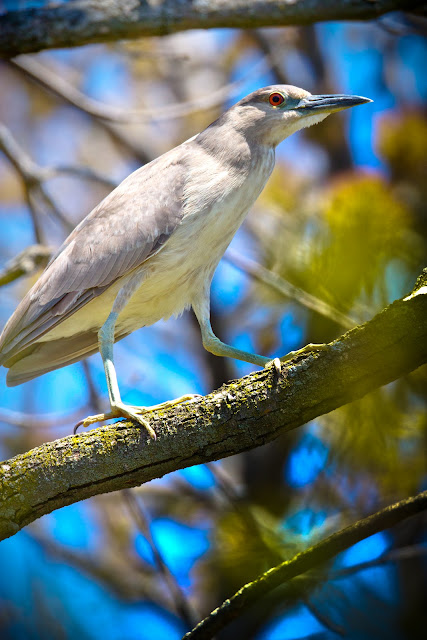When you think of a Black-crowned Night-heron you normally
picture a football-sized bird standing motionless at the water’s edge, disguised against tall marsh reeds and waiting for a meal to swim past…at least I do.
Seeing a Black-crowned Night-heron sleepy-eyed at the top of a
hundred-foot tree was strange and disconcerting.
I was looking for warblers in Lake Park,
Milwaukee. The spring migration is
on and the most interesting birds around right now are the multi-colored and
abundant varieties of warblers.
They’re everywhere!
They are passing through in flocks so large they
show up on radar. Spring is the
most exciting time to see warblers because now they’re displaying their most beautiful breeding
colors.
Walking through one of the park’s ravines I approached a
woman, sitting down, but looking up.
I asked her if she was watching anything interesting…a quite normal request between
birders. She pointed to the top of
a 100-foot tree and asked me what I thought that bird was.
I could barely see the bird a hundred-feet high, even with a
400mm lens. Being backlit, too, it was hard to determine its size or shape. I suggested a Cooper’s Hawk, but she
was pretty sure that wasn’t right. Posed as a question, she said, "Maybe a heron." It could be, I replied. She turned out to be right.
At this distance and poor angle we decided to walk to the
top of the ravine for a better look.
That put us fifty-feet closer and in full sunlight. Now it was possible to see two Black-crowned Night-herons…an adult and juvenile. Black-crowned Night-herons look alike
as adults, but juveniles hold on to their mottled brown plumage for the
first year.
The ‘night’ in ‘Night-heron’ comes from their preference to
hunt at night. I’ve seen them hunt
during the day, but they are comfortable and capable of hunting at night. Being night hunters they
sleep during the daytime. That is
how we found these two…dozing in the treetops.
Sleeping in a tree might seem scary to a human, but it's quite
normal for a bird. From time to
time their eyes would droop closed giving me the impression they were
dozing-off. I don’t know what a
Black-crowned Night-heron looks like actually sleeping, so I’m making an
assumption.
When they were awake it was obvious they were awake. Those big red eyes shone in the
sunlight. Walking branches like super-highways, they gave me
every indication they were capable of sleeping comfortably in a breeze off Lake Michigan.
When the wind blew you could see their unique feather-like
plume projecting from the back of their black-crowned head.
They were quite accommodating being photographed. They remaining
in place even as I was leaving.
Today I went looking for little warblers, but found huge, by comparison, Black-crowned Night-herons instead.
I can’t complain about that.
Allan











+5-21-2013-8786.jpg)








































